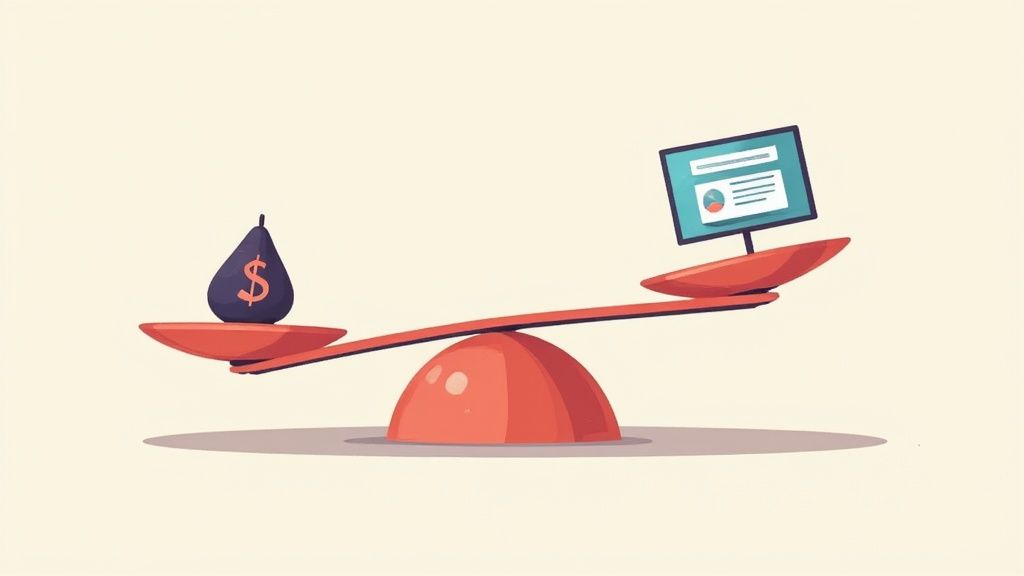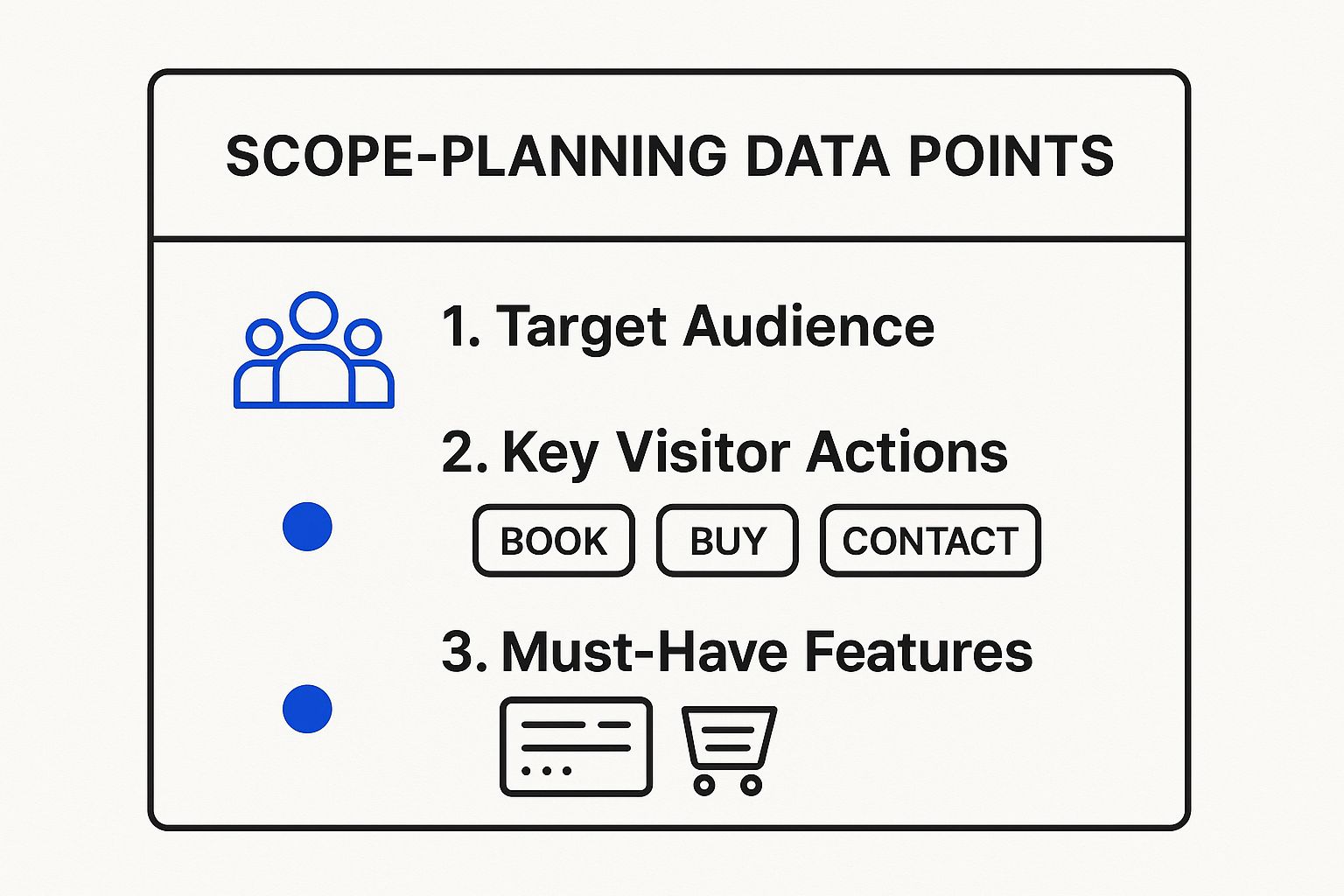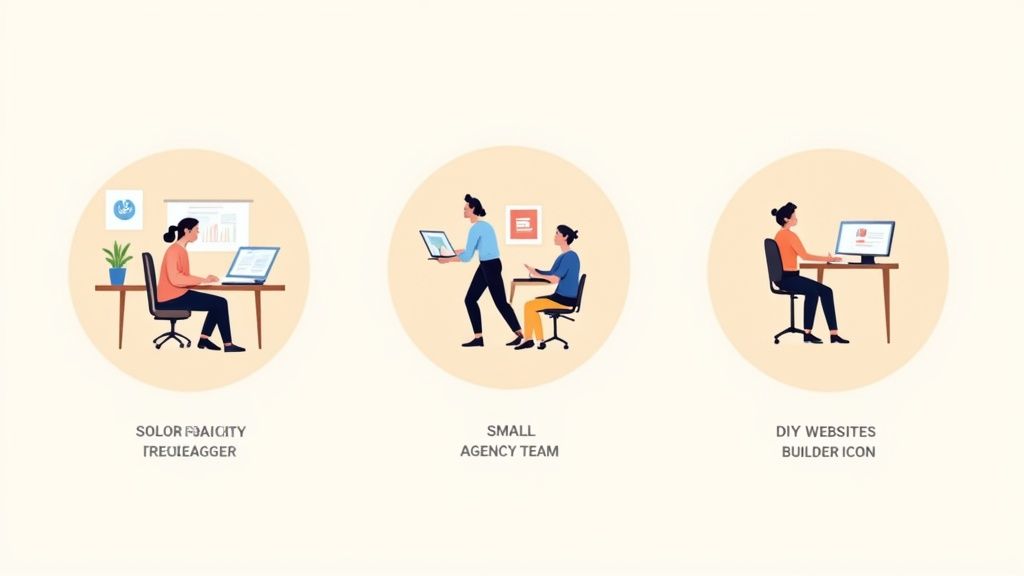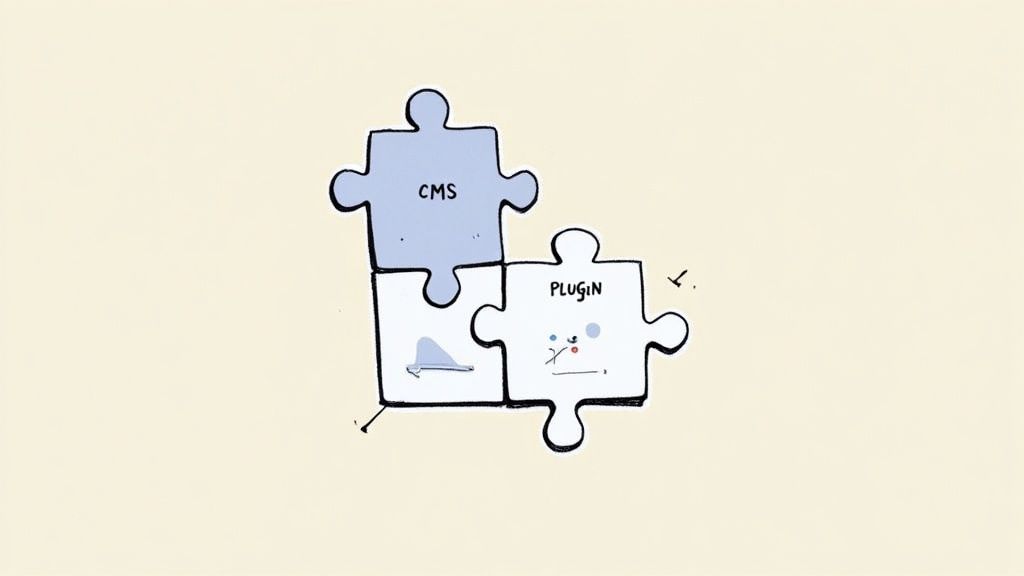
Think 'custom web design' means big-agency prices? Let's rethink that. For most small businesses in the UK, the real sweet spot isn't between a cheap template and a five-figure project. It's about getting a strategic design that delivers genuine business value without breaking the bank.
Finding Value in Affordable Custom Web Design
Investing in an affordable custom web design is really about putting your money where it counts—focusing on what your business actually needs to grow. It's time to move past the idea that 'custom' always means expensive and realise it just means specific. Instead of paying for flashy features you'll never use, every penny goes towards things that get you tangible results.
This approach is all about separating the essentials from the 'nice-to-haves' that quickly inflate the final bill. For a local plumber, an essential might be a dead-simple, reliable booking form. For a consultant, it’s a polished portfolio that shows off their expertise. The whole point is to build a digital presence that works as hard as you do.
Focusing on Return on Investment
A successful affordable website isn't measured by its price tag, but by its return on investment (ROI). Every pound you spend should be working towards a business goal. A huge part of getting real value from your investment comes down to the strategies detailed in this comprehensive guide to website conversion rate optimization. Shifting your mindset from cost to value is absolutely critical.
This focus on value is being felt across the UK. The web design industry hit a market size of around £1.4 billion after a 4.2% growth spurt between 2017 and 2022. That surge is largely down to small businesses looking for professional, tailored online solutions that don't come with an enterprise-level budget.

The real power of an affordable custom site lies in its precision. It solves your specific business problems—like generating leads or streamlining bookings—without the financial burden of a massive, all-encompassing project.
When you understand where your money is best spent, you can approach the whole project with clarity and confidence. The key is to map your investment directly to the outcomes you want:
- Increased Enquiries: A clear call-to-action and a simple contact form.
- More Sales: An intuitive e-commerce checkout process.
- Better Client Onboarding: An automated booking or scheduling system.
By prioritising features that either make you money or save you time, you make sure your website is a strategic asset. You can see these principles in action by checking out our guide on how we approach affordable small business website design. This focus is what turns your website from a simple expense into a powerful engine for business growth.
Defining Your Website Scope to Control Costs
The fastest way for an affordable custom web design project to spiral into an unaffordable nightmare is through something called scope creep. We’ve all seen it happen. It’s the slow, sneaky inflation of the budget caused by a string of "just one more thing" requests. Your best defence against this is a clearly defined project scope, which acts as a blueprint to keep everyone on the same page and avoid nasty financial surprises down the line.
Before you even think about picking up the phone to a designer, you need to get crystal clear on what your website absolutely must achieve. This isn't about making a wish list of every cool feature you've ever seen online. It's about nailing down the essentials that will genuinely drive your business forward. Without that clarity, you're asking a designer to guess what you need, and that's a surefire recipe for wasted time and money.
Start with Your Audience and Goals
First up, who are you actually trying to reach? Think about it. A local plumber in Midlothian needs to connect with homeowners in the middle of an emergency. Their website has to be simple, work brilliantly on a phone, and make the contact number impossible to miss. That’s a world away from a business consultant targeting Scottish SMEs, who needs a polished, professional site that builds instant credibility with case studies and downloadable guides.
Once you know your audience, the next step is to identify the three to five key actions you need them to take. These are your non-negotiables.
- Book an Appointment: Absolutely essential for service businesses like hairdressers or mechanics.
- Request a Quote: Critical for tradespeople, consultants, and most B2B services.
- Purchase a Product: The core function of any e-commerce store.
- Download a Guide: A fantastic lead-generation tool for experts and coaches.
- Fill Out a Contact Form: A versatile goal that works for almost any business.
This simple exercise forces you to prioritise what really matters. Everything else is just a "nice-to-have" for later.
This summary breaks down the core pillars of effective scope planning: understanding who you're talking to, defining what you need them to do, and listing the features that make it happen.

Focusing on these three areas ensures every penny of your budget is spent on functionality that directly supports your business goals.
Create Your Must-Have Feature List
With your goals locked in, you can now list the specific features needed to hit them. If your main goal is to generate enquiries, then a simple but effective contact form is a "must-have." If you're selling products, a shopping cart and a secure payment gateway are non-negotiable.
A well-defined scope isn't about limiting your website's potential; it's about focusing your investment on the features that deliver the highest immediate value. You can always add more in a later phase.
Think of it like building a house. You start with the foundations, walls, and roof before you even start looking at fancy light fixtures. To get a better sense of how different features impact the final cost, our overview of UK web design pricing can provide some valuable context.
By giving a designer a tight, well-reasoned brief, you empower them to give you a precise and genuinely affordable quote for a custom website that does exactly what you need it to. No fluff, no guesswork.
Choosing the Right Partner: Agencies vs Freelancers
With a solid project brief in hand, you’re ready to find the right talent to bring your vision for an affordable custom web design to life. This is a crucial decision. Who you choose—a design agency, a freelancer, or even a DIY platform—will directly shape your budget, timeline, and the final quality of your website.
Each path has its own pros and cons, so let’s break them down.
A full-service agency gives you a comprehensive, team-based approach. You get access to a whole crew of specialists—designers, developers, copywriters, and project managers—all under one roof. This is ideal for complex projects, but it naturally comes with a higher price tag to cover their overheads.
Working with a freelancer, on the other hand, offers a more direct and often more affordable route. You’ll be dealing one-on-one with a dedicated professional, which can make the process feel more personal and agile. This is a fantastic option for businesses that have a clear vision and a well-defined scope.
Weighing Your Options
The key is to match your project's real needs with the right provider. An agency's higher cost is often justified when you need extensive strategy, branding, and ongoing marketing support alongside the actual web build. They manage the entire process, making it a pretty hands-off experience for you.
A freelancer is an excellent middle ground, providing professional quality without the hefty agency overheads. Honestly, the rise of skilled freelance professionals has been instrumental in making custom web design more accessible for UK businesses. Platforms like Upwork show a huge concentration of UK web design talent offering competitive rates, which is brilliant news for startups and small businesses.
Then, of course, there’s the DIY (Do-It-Yourself) route with builders like Squarespace or Wix. While they're tempting for their low initial cost, they demand a significant investment of your own time. Achieving a truly custom and professional feel can be a real challenge, and you might find yourself hitting the limits of the platform as your business grows.
Choosing your partner is less about finding the cheapest option and more about finding the best value. Consider your own time, technical comfort level, and the complexity of your project before making a decision.
To help you see the wood for the trees, here’s a quick comparison of your main options.
Comparing Web Design Options for Your Business
This table breaks down the key differences between hiring an agency, working with a freelancer, and using a DIY platform. Use it to figure out which path best aligns with your budget, timeline, and ambitions for your affordable custom web design project.
| Factor | Web Design Agency | Freelancer | DIY Website Builder |
|---|---|---|---|
| Cost | Highest (due to overheads and team size) | Moderate (professional quality without agency fees) | Lowest (monthly subscription, but your time has value) |
| Expertise | Team of specialists (design, dev, SEO, copy) | Specialised in one or two core areas | You are the expert; relies on your own skills |
| Process | Structured, managed process with a dedicated PM | Direct one-on-one collaboration and communication | Entirely self-directed; you manage everything |
| Best For | Complex projects, businesses needing full-service support | Well-defined projects, businesses with a clear vision | Simple sites, tight budgets, and those with time to learn |
| Your Involvement | Low to moderate; agency handles most of the work | High collaboration; your input is crucial | Very high; you do all the work from start to finish |
Ultimately, understanding the strengths of each option helps you make an informed choice. A well-structured agency can deliver a robust, multi-faceted digital presence, while a skilled freelancer can provide a high-quality, focused solution.
To get a deeper insight into how a professional team manages a project from start to finish, you can explore our guide to the typical website design process. This will help you know what to expect, regardless of who you hire.

Using Smart Tech for a Custom Feel on a Budget
The idea of a "custom website" often brings to mind eye-watering invoices and developers coding away for months. But here’s the thing: achieving a truly bespoke site doesn’t mean your developer has to build every single component from scratch. That ground-up approach is exactly what sends costs soaring.
The real secret to an affordable custom web design lies in making clever technology choices that deliver a unique feel without the unique price tag.

This is where a flexible Content Management System (CMS) completely changes the game. A powerful CMS is the engine of your website. Instead of building that engine from individual nuts and bolts, you’re starting with a high-performance model and focusing your budget on customising the bodywork and interior to match your brand perfectly.
The Power of a Solid Foundation
By a country mile, the most popular and flexible choice is WordPress. Its incredible adaptability is a key reason why it’s the cornerstone of affordable web design in the UK. In fact, in 2023, WordPress was used by over 60% of all UK websites that rely on a CMS. You can dig into the UK's CMS market share on W3Techs.
This huge adoption means there’s a massive, well-supported ecosystem of tools built around it. A savvy developer can start with a premium theme that already aligns with your brand’s general look and feel, saving you thousands of pounds and weeks of development time right out of the gate. It provides the core structure, which can then be tailored to your exact needs.
Think of a premium theme as the architectural blueprint for your website. It sets out the layout and foundational design, but your developer acts as the interior designer, bringing your unique brand identity to life within that space.
From this strong starting point, specific functionality is layered on using well-vetted plugins. These are pre-built software components that add features to your site, completely removing the need for costly custom development for common requirements.
This approach gives you the best of both worlds: the cost-effectiveness of proven technology combined with the unique finish of a custom build. The result is a website that looks and functions like it was made just for you, but was built far more efficiently.
Adding Functionality with Plugins
This is where the real magic happens. By strategically selecting plugins to meet the goals you defined in your project scope, you can build a feature-rich site without breaking the bank. This modular approach is central to creating an affordable custom web design that doesn’t compromise on capability.
Need to let clients book appointments directly on your site? There are robust plugins for that. Want to start selling products? A dedicated e-commerce plugin can handle everything from inventory to secure payments.
Here are a few real-world examples of how plugins add custom functionality affordably:
- Booking Systems: A local salon can integrate a full calendar and appointment system.
- E-commerce: A freelance artist can add a professional shop with a secure checkout.
- Advanced Forms: A consultant can create detailed quote request forms to capture all the necessary info upfront.
- SEO Tools: You can enhance your site's visibility in search results without needing any manual coding.
The key is to use high-quality, well-supported plugins that won't slow your site down. Efficient code and smart plugin choices are fundamental to good performance. Our guide on website performance optimization explains exactly how these choices impact speed and user experience.
Armed with this knowledge, you can have much more intelligent, cost-saving conversations with your developer. It ensures you get a scalable and efficient site that’s a perfect fit for your business, both now and in the future.
Making Sense of Proposals and Contracts
Getting that first proposal is a brilliant moment. It’s when your idea for a new website stops being just a conversation and starts to feel real. But this is also where you need to switch gears from creative chats to the nitty-gritty of the agreement. A bit of focus here saves a world of headaches later on.
A good proposal should feel like a summary of every conversation you've had so far. It needs to reflect your business goals, who you’re trying to reach, and the specific problems this new website is going to solve. If it reads like a generic template they could have sent to anyone, that’s a bit of a red flag. The best partners show they’ve been listening from the get-go.
And please, don't just skip to the price at the bottom. The real value is in the detail. Vague lines like "Web Design" or "Development" just aren't good enough – you need to know exactly what you're paying for.
Scrutinising the Deliverables
A solid proposal will itemise every single thing you’re getting. This is your chance to make sure nothing has fallen through the cracks. Look for clear, specific commitments on:
- Number of Pages: It should list the exact pages being designed and built (e.g., Home, About, Services, Contact). No ambiguity.
- Specific Features: It needs to name every piece of functionality you agreed on, whether that’s a contact form, a blog, a gallery, or an appointment booking system.
- Content Management System (CMS): This confirms the platform (like WordPress) and, crucially, should clarify if you’ll get training on how to actually use it.
- Responsive Design: The proposal must explicitly state that the site will work perfectly and look great on desktops, tablets, and mobiles.
If something you discussed isn't on this list, now is the time to bring it up. It’s so much easier to get it added to the scope at this stage than it is when the project is already halfway built.
Understanding the Contract Essentials
Once the proposal looks spot on, the contract is what makes it all official. It might look a bit intimidating, but a good contract is there to protect both of you by making everything crystal clear. It should never feel like a one-sided document.
Keep an eye out for these essential clauses. They’re the bedrock of a fair and transparent partnership.
- Project Timeline and Milestones The contract needs a clear schedule with dates for the key stages: initial design mock-ups, the development phase, your feedback rounds, and the big launch day. This is what keeps everyone on the same page and the project moving forward.
- Payment Schedule For most projects of this size, a 50% upfront payment with the final 50% on completion is pretty standard stuff. This structure shows commitment from both sides. Be very cautious of anyone asking for the full amount before any work has started.
- Intellectual Property Rights This one is massive. The contract must state that once the final payment is made, you own 100% of the website design and code. This is non-negotiable. It ensures you have full control over your digital asset forever.
- Revisions and Feedback The agreement should define how many rounds of revisions are included at each stage. This simple clause is brilliant for preventing "scope creep"—those endless little changes that can derail a project—and keeps everything focused.
- Post-Launch Support So, what happens after the site goes live? A good contract will specify a support period (often 30 days) to fix any little bugs or issues that might pop up once the site is out in the wild.
Negotiating your contract isn't about being difficult; it's about building a strong foundation for a successful partnership. Getting clear expectations down on paper from the start is the best way to ensure your affordable custom web design project gets finished on time, on budget, and without any nasty surprises.
Got Questions About Custom Web Design?
Diving into the world of web design can feel a bit much, especially when you're trying to get something brilliant without a bottomless budget. To help you make the right calls with confidence, we’ve answered a few of the most common questions we hear from UK businesses.
These are the real-world queries that pop up time and time again.
What’s a Realistic Budget for a Small Business Website?
Honestly, a realistic starting point for a professionally built, simple custom website from a UK freelancer is around £1,500. That would typically get you a clean, responsive "brochure" style site with the core pages sorted: Home, About, Services, and Contact.
If you’re thinking bigger and need features like e-commerce, custom booking systems, or more involved content work, you’ll likely be looking at £5,000 or more, particularly if you're working with a small agency. The final cost always comes down to the scope and complexity of your project.
For more answers to common queries, you might find this comprehensive website design FAQ helpful.
How Long Does It Take to Build a Custom Website?
For a standard small business site, a typical timeline is somewhere between four to eight weeks from the first chat to the final launch. This gives everyone enough breathing room for proper discovery, design, development, and your feedback.
A few things can nudge that timeline:
- Project Complexity: An online shop with hundreds of products will naturally take longer than a simple five-page informational site.
- Your Feedback: How quickly you can provide content and thoughts on the design mock-ups plays a massive part in keeping things moving.
- The Designer's Schedule: A good designer is usually a busy one, so their existing workload will always be a factor.
Your single best tool for keeping the project on track and avoiding delays? A crystal-clear project brief from the get-go.
Will I Be Able to Update My Website Myself?
Yes, absolutely. Any modern custom website worth its salt should be built on a user-friendly Content Management System (CMS) like WordPress. Think of the CMS as the control panel for your website, giving you the power to make changes without ever needing to touch a line of code.
Your ability to manage your own content is non-negotiable. It means you can keep your site fresh, publish blog posts, and update key info – all of which is vital for your audience and for SEO.
When you're discussing the project, make sure CMS training and a clear handover process are included in the proposal. It’s the best way to ensure you feel totally confident managing your new digital home from day one.
What Happens After My Website Is Launched?
Launch day is just the beginning of the journey. A professional designer or agency will usually include a post-launch support period, often around 30 days, to iron out any little bugs or issues that might pop up once the site is live.
After that, ongoing support is crucial for keeping your site secure, updated, and performing at its best. It's smart to learn more about why ongoing website maintenance and support is so important for protecting your investment in the long run.
Ready to build a high-performing website that drives real results for your business? At Altitude Design, we specialise in creating custom, lightning-fast websites for businesses across Scotland. Get your instant fixed-price quote today!